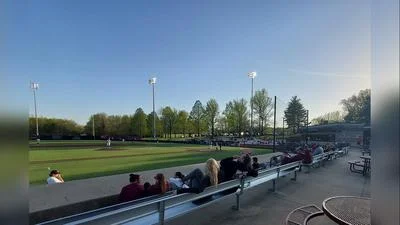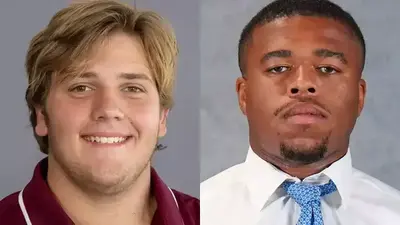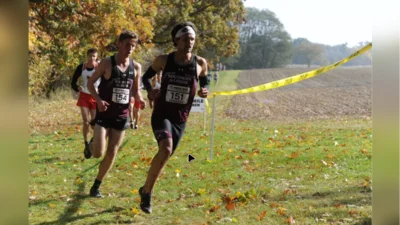On a wind-swept hill, in a meadow near one of the area’s many premier vineyards, Southern Illinois University Carbondale zoology student Samantha Dennis was spending a sunny autumn day following her dream of becoming a professional conservationist.
Beneath her feet, radar waves penetrated the layers of soil, bouncing back to reveal the hidden homes of crayfish, a common but ecologically critical, and little-understood creature whose short, chimney-like mud structures bely their presence.
“They are all over this meadow. You can’t walk 10 feet without seeing more,” said Dennis, a senior from Bloomington, Indiana, who is using electromagnetic waves and software to dig deep into the lives of upland burrowing crayfish. “They are a keystone species, and the fact that we know so little about them, especially what they do underground, is very intriguing to me. And using the ground-penetrating radar and trapping is completely noninvasive to the meadow.”
Dennis said SIU’s national reputation for involving undergraduate students directly in hands-on research brought her from the Hoosier State to Southern Illinois. Her efforts quickly led her to the office of Harvey Henson, director of SIU’s STEM Education Research Center, who offered to help Dennis pick up an underground study of local crayfish where a former graduate student of his had left off.
Henson, a geologist and researcher, had spent years using GPR to study underground structures and historical events, such as lost gravesites along the Trail of Tears. Along the way, he had noticed features in the data that appeared to be associated with the telltale crayfish chimneys.
“It made me wonder if we could use the GPR to describe these underground structures that no one had seen before,” Henson said. “Turned out yes, we could see them.”
Henson guided then SIU graduate student Zachariah Seaman through the initial studies, which confirmed the GPR’s ability to spot the crayfish lairs and to some extent model them using advanced software. But Henson knew there was still more to learn after Seaman completed his graduate work.
Learn by doing
That’s when Dennis showed up at his door. And before long, she was learning to use the high-tech, three-wheeled GPR unit by running it up and down the corridors of Pulliam Hall on the SIU campus.
“Dr. Henson gave me the manual and pointed to it and said, ‘Here it is. Go practice,’” she said. “After a few days, I got pretty good at it and learned how to troubleshoot problems. So, we headed out to the field.”
Her initial work started late in 2020, and by 2021, Dennis had earned a REACH (Research-Enriched Academic Challenge) grant from the university, which can provide undergraduates up to $2,000 for a one-year research project.
“The REACH scholarship really got things moving,” Dennis said. Early 2021 saw her learning to trap the crayfish during the breeding season (before releasing them) and using the GPR unit to further illustrate their unseen life below ground.
Cross-disciplinary approach is key
SIU embraces an approach to research that applies expertise from multiple disciplines to the issue at hand. In the case of the crayfish, that means bringing together geology, zoology and soil science to tease apart the many strands of data to better interpret their meaning.
On this day, Amanda Weidhuner, a researcher with the STEM Education Research Center and specialist in plant and soil science, used a heavy truck with specialized equipment to force a coring tool up to 2 meters (about 6.5 feet) deep. The tool extracts stratified soil cores for analysis.
“We take the soil profile and look at each soil horizon,” Weidhuner said. “After we type it, we look at what horizons correlate with where we can see the burrows on radar, to try and figure out what the crayfish prefer.”
The cores also reveal important information about the crayfish’s ability to avoid the plow zone on top of the soil, as well as whether it can get through the soil’s hardpan, a rock-hard layer of material close enough to the surface to limit the ability of plants to extend their roots and to prevent internal drainage of the soil. The soil hardpan location can vary from a few inches to 2 or 3 feet.
The cores also can tell Weidhuner about the local water table – where it normally resides as well as its low and high points – which may also have a bearing on how the crayfish live.
“We don’t know a lot about crayfish, so anything new we’re learning here is important,” she said. “And I love cross-disciplinary research because of the collaboration, the unification of ideas and the fact that I can help study things outside my very specialized field. I love working in a team effort and always feel more can be learned that way.”
Methodical search, and the road ahead
Dennis, who graduates in May with a Bachelor of Science in zoology and wildlife biology specialization, uses a 3-by-3-meter (almost 10-by-10 foot) plexiglass sheet marked with rows of tape 5 centimeters apart to designate each section of ground she examines. After doing 61 passes in one direction, she turns the GPR 90 degrees, crisscrossing the previous pattern to capture both and X and Y axis.
The effort takes about four hours.
She then downloads the radar data into specialized software that can render a two-dimensional image on the screen that represents a cross-section of the subsurface. With some more editing and manipulation, the software can create what is essentially a 3D image, showing size, depth and other important details of the crayfish’s buried neighborhood.
“It’s fascinating, and I have found up to 11 burrows in a single search area,” Dennis said. “In those cases, some are not active burrows but what we call ‘ghost burrows’ that are not being used and have sometimes partially collapsed. But we’re learning more every day.”
Dennis said all of this hands-on undergraduate work will likely help put her ahead as she searches for a graduate school to continue her studies.
“At a lot of other universities, you don’t get research opportunities until maybe during your senior year if you’re lucky, so that was a big reason I came to SIU. I started doing research like this during my sophomore year,” she said. “Zoology grad schools want you to have those hands-on skills, so this should make me very competitive.”
Ultimately, Dennis hopes to study and conserve wildlife.
“I want to work directly with species in the field,” she said. “I want to make a real difference.”
Original source can be found here.




 Alerts Sign-up
Alerts Sign-up